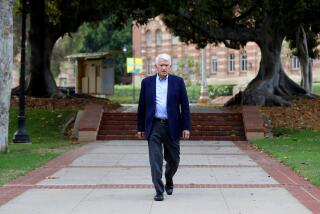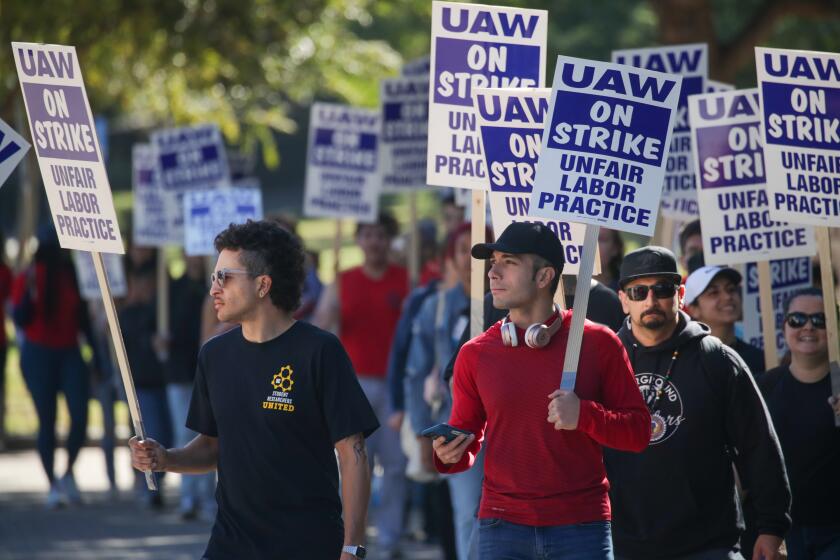State’s Manicuring Schools, Shops Receive Little Oversight
After searching through the worn desks, dogeared notebooks and snapshots of smiling graduates at Tam’s Beauty College, state investigators reported some startling discoveries.
Teachers often ditched their own classes, the investigators said, and some lessons were taught in English--although most students spoke only Vietnamese.
Pupils skipped classes, too, and tampered with a time clock to more quickly accumulate training hours. Classrooms were infested with roaches, investigators said, and the stench of mold, mildew and urine hung in the air.
Alarmed at the conditions at Tam’s, tucked in a strip mall on the edge of Orange County’s Little Saigon community, state officials took the unprecedented action last month of shutting down the school.
Officials stress that the majority of the state’s 179 accredited beauty schools provide solid services and skills that each year help launch careers for thousands of students, many of whom receive federal loans and grants. But the conditions at Tam’s offer a glimpse into what officials describe as a worsening problem in California’s estimated $2-billion-a-year manicuring industry.
This year, more than 40% of California’s cosmetology students failed their exams, suggesting inadequate training, said Betsy Imholz, spokeswoman for the San Francisco-based Consumers Union, which monitors vocational schools.
Cheating on licensing exams has become a persistent problem involving students and instructors, according to state authorities who license and regulate the industry.
*
State inspectors say they barely have enough staff to adequately respond to the 2,250 complaints so far this year from beauty school students, salon patrons who were injured by poorly trained manicurists and others.
These problems often shortchange thousands of predominantly Vietnamese students and unfairly tarnish the image of nearly 84,000 licensed manicurists statewide and about 40,000 salons and beauty schools, industry watchdogs say.
“The industry has grown immensely. With that, we are seeing bigger problems,” said Susan Harrigan, assistant program administrator for the state’s Barbering and Cosmetology Program, which regulates the industry’s health and safety standards.
The broader public concern, she said, is about the potential health risks involved as manicurists routinely use sharp instruments to snip cuticles and handle harsh chemicals around customers.
Van Thai Tran, the attorney representing Tam’s owners, said criticism of the school has been exaggerated. He said school owners admit there were problems at Tam’s and were willing to remedy them, but they didn’t have enough time or money to do it by the state’s deadline.
“My main contention is that if you go into any school, you’ll find one violation or another. . . . Tam’s was [the state’s] sacrificial lamb,” Tran said.
Beauty colleges catering to immigrants emerged about 10 years ago, as a new wave of refugees faced cutbacks in federal aid. Cosmetology-related professions, especially manicuring, were appealing because students could invest as little as $250, some additional money for tools and about three months of training.
Le Nguyen, manager of Little Saigon’s Asian-American International Beauty College, defends the industry as the “stairway leading immigrants out of poverty, out of welfare.”
“Thousands of students are productive, taxpaying citizens today because we were there for them,” said Nguyen, whose students have won international awards.
State officials say they recognize the need for more regulation of the industry.
In recent months, they have added two inspectors and are scrambling to hire more, partly in response to calls for greater regulation from some of the profession’s trade associations, salon owners and others.
*
Problems that critics say the industry and state regulators should address include:
* The need for more state inspectors. Nine Sacramento-based inspectors are charged with monitoring all the colleges, salons and manicurists, more than 124,000 businesses or licensed individuals.
* The flood of new students. Although federal regulations require schools to place at least 70% of all graduates in jobs, there are still seven beauty school graduates for every job available statewide, according to a 1997 U.S. General Accounting Office report.
* Widespread cheating. Over the past three years, hundreds of students statewide have been disqualified from taking licensing exams because of cheating, according to state officials. A Vietnamese-language exam is now in use because some 1995 test-takers were caught cheating with the help of a translator.
* The wisdom of taxpayer subsidies. The federal government provides loans and grants to low-income vocational students and others. In 1990, $725 million in federal funds subsidized 96,000 cosmetology school graduates nationwide, according to the U.S. Department of Education. The glut of workers raises questions about whether taxpayers should foot the bill.
* Difficult working conditions. The oversupply of students has created an intensely competitive environment, where manicurists try to drum up business by dropping prices. That’s not a problem unless--as some critics fear--safety and quality controls are compromised in an attempt to cut costs.
A dirty workstation or an improperly sterilized tool can spread bacteria and diseases, causing infections that can lead to serious injuries, Harrigan said.
A Sacramento woman recently had a finger amputated because of a blood infection caused by unsterile tools, and state officials said they have found other cases in which customers were injured.
Harrigan said such incidents usually include manicurists mishandling equipment or chemicals. Rashes and nails that fall off are just a few of the results.
In many cases, citations are issued and violators are asked to submit a letter saying they have corrected the problems, sometimes in addition to paying fines of $25 to $1,000, Harrigan said. Unless a case involves severe health hazards, inspectors do not have time to do follow-up checks, state officials conceded.
Authorities revoked 21 licenses of individuals and salons statewide in the fiscal year that ended in June, compared to 13 revocations the previous year. In the past four months, 11 business and individual licenses have been revoked.
“Keep in mind, though, that in terms of numbers, it amounts to only a small portion of the industry. . . . But it’s that small percentage that’s giving the wrong impression,” Harrigan said.
Little Saigon, with six schools, has one of the state’s highest concentration of beauty colleges, and draws students largely from Orange County’s Vietnamese community--the largest outside Vietnam.
Although exact figures are not kept, industry experts estimate that Vietnamese immigrants constitute 60% to 80% of the manicurists in California and 40% to 60% elsewhere in the nation.
Success stories abound of refugees who are making thousands of dollars weekly doing nails, sometimes charging up to $100 for elaborate services in posh surroundings.
But in many of the discount salons that dot area street corners, manicures and pedicures are offered for as little as $10. That means manicures now are affordable to more people, including teenagers with weekly allowances.
Critics say an all-out price war has been waged at the expense of customers and workers. Many immigrants toil long hours and generally do not earn as much as their non-Asian counterparts, said Janet Borgens, vice president of the California Cosmetology Assn. Many also work six days a week without benefits--effectively earning incomes below minimum wage, she said.
“That’s exploitation in my mind,” Borgens said.
(BEGIN TEXT OF INFOBOX / INFOGRAPHIC)
Ensuring a Safe Manicure
State officials say that with only nine Sacramento-based inspectors overseeing about 40,000 beauty salons and schools statewide, they depend on consumers to do their part by promptly reporting suspicious activities. Things to look for:
* Licenses: Insist on seeing the manicurist’s license, check the expiration date and you may even ask to confirm it with a driver’s license or other forms of identification.
Make sure the establishment has a license and a health and safety poster within view of all customers. The poster (20 inches by 12 inches) offers consumer protection information, as well as a toll-free number to call if there are problems: (800) 952-5210.
* Workstation: Examine the workstation. It should be clean, with a fresh towel for every customer. There should be no nail clippings from previous customers scattered about. Disposable tools should not be reused.
* Tools: Pay attention to the tools. They should be stored in a covered container or soaked in disinfectant. The disinfectant should be clear, not cloudy, which could be a sign that it is no longer effective or is a substitute for disinfectant.
* Equipment: Nail-drilling equipment should not be used on natural nails.
* Hand Washing: Make sure manicurists wash their hands and ask you to wash your hands before work begins. This helps limit the spread of bacteria.
Sources: California Department of Barbering and Cosmetology, California Cosmetology Assn.
Los Angeles Times
More to Read
Start your day right
Sign up for Essential California for news, features and recommendations from the L.A. Times and beyond in your inbox six days a week.
You may occasionally receive promotional content from the Los Angeles Times.






